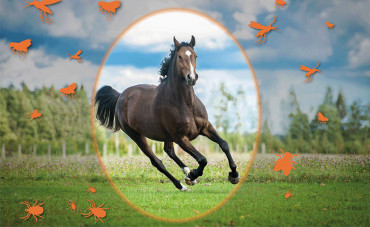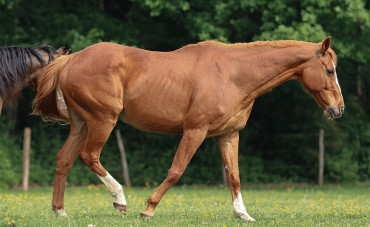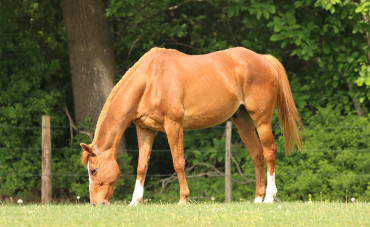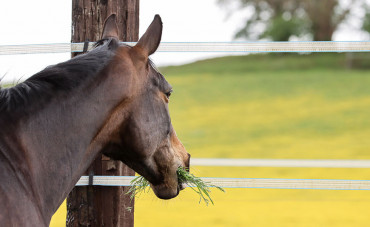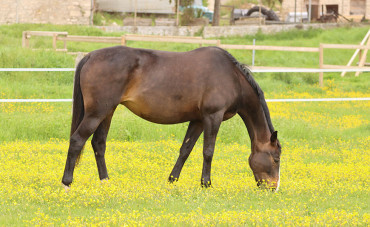In recent years, you may have heard of the horse flu epidemic. In this article, we take a closer look at horse flu, a highly contagious respiratory illness caused by a virus.
What is horse flu?
Equine influenza, or horse flu, is an extremely contagious viral respiratory condition which can affect all equines: horses, donkeys, mules, etc.
The agent responsible for horse flu is a type-A influenza virus. This is the same type of virus that causes flu in humans, though it involves a different subtype. In horses, the two subtypes responsible for horse flu are: H7N7 and H3N8. Even though the horse flu virus is closely related to human flu, no case of transmission between horses and humans has ever been observed.
When a horse is infected with equine influenza, the flu virus will multiply within the epithelial cells of the horse’s respiratory tract. This leads to a destruction of the mucus membranes, causing the respiratory symptoms of horse flu. What’s more, this makes the horse’s airways more sensitive to secondary infections, which can increase inflammation and complicate recovery.
Transmission of horse flu between horses
Horse flu is, without a doubt, the most contagious illness for horses. In just a few hours, it can infect an entire stable.
The virus is spread through the airways and infection can occur in two ways:
- Direct transmission: when a sick/contaminated horse coughs or sneezes, it excretes a significant quantity of the virus which may directly reach a healthy horse
- Indirect transmission: even though the virus is not particularly resistant once outside of the body (a few days), infection may occur if a person grooms sick/contaminated and healthy horses using the same equipment. This indirect infection is also possible if a healthy horse spends time in a place previously occupied by a sick horse (stall, transport, etc.)
It’s important to remember that infected horses who have no, or few clinical symptoms (healthy carriers) can transmit the virus just as easily as highly symptomatic horses.
The symptoms of horse flu
In the case of horse flu, incubation—the time between infection and the appearance of the first symptoms—is considered to last between 2 to 5 days.
Among the most characteristic symptoms of horse flu, there are three overarching categories:
- General symptoms:
-> Fever (temperature above 38.5°C, which may rise to over 40°C)
-> Despondency
-> Reduced performance
-> Decreased appetite
- Respiratory symptoms
-> Heavy dry cough
-> Serous (translucent) nasal discharge for the first few days. This may become thicker and white if the horse develops a superinfection
-> Respiratory difficulties
- Other symptoms (less frequent)
-> Muscle stiffness
-> Swollen limbs
-> Discharge from the eyes
As in many illnesses, clinical signs will vary from one horse to the other according to their sensitivity, age and vaccine status. Again, even horses presenting only a few symptoms may infect other horses and their environment.
In addition to symptoms linked to horse flu, horses may present with other clinical signs as a result of superinfections. Put simply, in horses affected by the flu, the airways are more vulnerable to opportunistic bacteria, which may lead to secondary infections complicating the horse’s treatment and healing.
Though horse flu is rarely fatal in adult horses, more vulnerable horses (foals or older horses, for example) may die following secondary infections (bronchitis, pneumonia, etc.).
One of the risks of flu is that, after recovery from the acute period, the horse will continue to suffer the after-effects. Most often, these are respiratory in nature, with lung fragility such as emphysema, for example.
Diagnosing horse flu
The combination of symptoms and the rapid spread of the disease in a stable will often guide your vet’s diagnosis of horse flu. As symptoms may be similar to those of other conditions, like equine herpesvirus, strangles or a bacterial infection, it’s important to narrow down the diagnosis.
To confirm their diagnosis, your vet may carry out two types of tests:
- A PCR test which will directly indicate the presence of the virus. This requires a nasopharyngeal sample: a very long swab is entered into one of the nostrils to take a sample of the pharynx cells.
- A blood test, which will detect anti-bodies. This method is harder to interpret as, in vaccinated horses, it is difficult to tell the difference between antibodies resulting from the vaccine and those resulting from infection. Often two blood tests will be taken to see if the rate of antibodies increases, thereby prolonging diagnosis time.
How to treat horse flu?
As horse flu is a viral illness, there is no specific treatment. Your vet may prescribe a treatment to mitigate the affected horse’s symptoms, if necessary. For example, in horses with a high fever, a non-steroidal anti-inflammatory may be prescribed.
In addition, as horse flu causes lesions to the respiratory tract, it’s important that the horse is rested for at least three weeks after symptoms clear up, to aid their respiratory tract’s healing and avoid any after-effects. Opt for a well-ventilated location, away from air currents, and a diet as low in dust as possible (wet hay if necessary).
As with all contagious illnesses, it’s important to isolate affected horses from healthy horses to avoid the spread of disease. You’ll also need to implement a care circuit: start by tending to healthy horses, then horses “in contact” with the illness, before finishing with the sick horses.
Finally, in the case of horse’s presenting with a bacterial superinfection, vets may prescribe the use of an antibiotic.
Preventing horse flu
One of the best ways to prevent horse flu is vaccination. Today, vaccination is strongly recommended as it makes it possible to limit excretion of the virus in the case of infection, reducing its spread. On top of this, vaccines can also reduce the severity of symptoms.
Foals are recommended to be vaccinated from the age of 6 months, especially if they are more sensitive to horse flu. Once the first vaccination regime has been completed (3 infections), boosters are carried out on an annual basis. The recommended period between boosters is 6 months in certain specific cases:
• Horses who regularly compete and therefore come into contact with a large number of other horses.
• Older horses whose immune response will be weaker.
In terms of vaccine protocol, your vet will be best equipped to offer you the right protocol for your horse.
In facilities where horses are moved around, new horses should ideally be isolated for several days in order to limit the risk of infection.
It’s also important to remember that horse flu is easily destroyed by common disinfectants. Regular and full cleaning of your facilities is a very effective sanitary measure to limit infection.
We hope this article has helped you to better understand horse flu. If you have any questions about your horse, get in touch with your vet as soon as possible. In the event of a “national” episode, follow the recommendations of RESPE (the French epidemiological network for equine diseases) and your vet to limit the spread of this epidemic.
If you have any questions, don’t hesitate to send us a message on our social media!



